
The “Sweet Spot” on the globe was New Orleans and the land surrounding it—Spanish Louisiana and West Florida and the Chickasaw and Choctaw Indian territories that would become Mississippi Territory in 1798. Both Britain and France coveted the lower Mississippi Valley as the ideal location for establishing a new country. Spanish officials wanted to extend their empire, or establish a new independent country. All three foreign powers actively sought the collaboration of American citizens. The country that controlled New Orleans could use it as a base to establish a new empire on the Gulf of Mexico that would take control of the Mexican silver mines. The wealth of the silver mines could finance any number of revolutions in the Spanish colonial empire in Central and South America. It was the Age of Revolutions, and the world was in an uproar.
General Wilkinson arrived in Philadelphia in October, 1796 with his wife Ann and 10 year old Joseph. Their two older sons, John and James, had been attending school in Philadelphia since 1792. En route, they learned the devastating news that 15 year old John, their oldest son, had died of yellow fever while they were on their way to see him.
Philadelphia was still serving as the nation’s capital city, and the Wilkinsons remained there for several months. President Washington had published his famous Farewell Address in September, almost two months before the first contested election for the American presidency was held in November, 1796. The address warned of the dangers associated with the newly established political parties. Alexander Hamilton had founded the Federalist Party in 1791, and Thomas Jefferson and James Madison had founded the Republican Party in opposition to it in 1791–1793.
The two parties represented a deep split in the American people, loosely characterized as being either pro-British or pro-French. The Federalist Party was committed to a strong centralized government, a national bank, manufacturing, and commercial ties with Great Britain. Its supporters were generally found in New England and the business community. The Republican Party was the party of farmers and frontiersmen, who opposed a strong central government; and favored states rights, an agricultural economy, slavery, and the French Revolution.
The development of parties had not been anticipated by the writers of the constitution. In the election of 1796—to the consternation of both parties—Federalist John Adams was elected president and Republican Thomas Jefferson was elected vice president. It was not until after the election of 1800 that a constitutional amendment allowed voters to choose a presidential and vice presidential candidates running together on the same ticket.
Wilkinson was given a seat of honor at the inauguration of President Adams on March 4th, 1797.173 Because of General Wayne’s death, the court of inquiry was not held, and congress abolished the rank of major-general which had been held by Wayne. Wilkinson had to be content with remaining a one-star brigadier general, although he was now the Commanding General of the United States Army.
The European wars of revolutionary France continued with an ever changing series of alliances between nations. After Spain and France became allies in August, 1796, King Carlos IV of Spain declared war against Great Britain. How did the revolutionary wars in Europe affect the United States? The Quasi-War between the United States and France took place between 1797 and 1801. It was a undeclared naval war, fought mainly in the Caribbean. The French were upset by the United States’ renewal of commercial ties with Great Britain under the Jay Treaty; and by the United States’ refusal to continue paying on debt it owed to France for its support during the American Revolution. The United States contended the debt had been owed to the French Crown, not to its post-revolutionary government.
French privateers seized 316 American ships engaging in trade with British colonies in the Caribbean in 1795. The Spanish also captured American ships. (Privateers were ships authorized by governments to capture enemy ships during wartime and split the proceeds with the sponsoring government.)174
Regarding the territories of Spanish Louisiana and the two Floridas, the Spanish minister Manuel Godoy summed it up neatly: “You can’t lock up an open field.”175 France was considered the most likely candidate to acquire Louisiana and the Floridas—either by negotiation with its ally Spain, or by force—which affected the decisions made by all four governments and domestic conspirators. Various plots were either to take possession of the lands before France did so, or to aid France in acquiring them. A leading historian of the time period, Arthur Whitaker, colorfully wrote that “the atmosphere of uncertainty brought forth a tropical profusion of plots.”176
Because Britain and Spain were at war, there was also a threat of a British invasion force coming down from Canada through the Mississippi Valley to seize Spanish territories. General Wilkinson, after settling his family in Pittsburgh, began a tour of forts in the Northwest reaching Detroit in June, 1797. In September, the Spanish agent Thomas Power met with him to deliver a confidential message from Baron de Carondelet, the Spanish governor of Louisiana and West Florida, who was based in New Orleans.
The Baron offered $100,000 in funds for Wilkinson to persuade the residents of Kentucky and Tennessee to secede from the union and form a new Spanish province east of the Mississippi. The province would extend from the mouth of the Yazoo River to the Ohio River. Wilkinson himself would be granted land in Illinois Country and receive a $4,000 annual pension.
Wilkinson replied that the opening of the navigation on the Mississippi had caused Americans to lose interest in such schemes. He told Power to inform Carondelet he had destroyed his cipher code and would no longer be acting as their agent. The General—who had received approximately $26,000 from Spanish authorities in the years 1790–1796—would stay off the Spanish payroll for the next seven years. However, he promised Carondelet the United States Army would oppose any attempt by Britain to seize control of the Floridas and Louisiana, as these were also his instructions from the Secretary of War.177
Governor Carondelet was attempting to block the plans of Zachariah Cox, an American speculator in the Yazoo lands east of the Mississippi, and/or the British plans to seize the Spanish territories. The lands on the east side of the Mississippi River were the homelands of the Chickasaw and Choctaw Indians (which later became Mississippi Territory) and Spanish West Florida with its access to the Gulf of Mexico. The area could become the center of a new British colony using New Orleans as its capital city; or it could become a rival to Mississippi River business interests by linking together the rivers which flowed into Mobile Bay. The Indian lands had not yet been acquired by the United States and were a magnet for real estate speculation and conspiracies for years to come.
In 1796, Zachariah Cox established a company to create a commercial water route from the Ohio River to the Gulf of Mexico at Mobile Bay. Cox’s plan started with establishing two settlements, one located at the mouth of the Cumberland River—on the Ohio, and the other at Muscle Shoals near the Great Bend of the Tennessee River. A short 35 mile carriage route from Muscle Shoals would connect the Tennessee River to the Tombigbee River which flowed into Mobile Bay. Cox’s route would shorten the travel distance from the Ohio River to the Gulf of Mexico, and would be in direct competition with New Orleans business interests.178
A partner of Cox, John Smith T. (the “T.” stood for Tennessee), established Smithland, Kentucky in 1796 at the mouth of the Cumberland River. Cox led a group of settlers to Muscle Shoals in 1797. These activities incurred the wrath of General Wilkinson who had Cox arrested at Natchez in August, 1798. The day before Wilkinson arrived at Natchez, Cox escaped from jail and fled to New Orleans.179 Secretary of War McHenry believed that Manuel Gayoso, the newly appointed Spanish governor of Louisiana and West Florida, “probably was in connivance” with Cox 180 as Gayoso refused to return him to American territory.181 Cox’s escape may well have been another instance of escaping an assassination plot by Wilkinson. However, a few years later, General Wilkinson and Smith T. became friends and associates in the St. Louis area.
General Wilkinson, in July, 1797, issued a proclamation at Detroit declaring Martial Law:
To guard the National Interests against the Machinations of its enemies, secret or covert, Foreign or Domestic—to baffle the Arts of Seduction, which have led to numerous desertions from the Public Service and to restrain licentiousness and the infamous habits of drunkenness encouraged among the Troops by the disorderly conduct of the vendors of Ardent Spirits. The Commander-in-Chief thinks it is a duty appurtenant to the high trust reposed in him, a duty of indispensable obligation to declare Martial Law within the line of the Guards and limits of the Fortifications of the place … 182
Martial Law was needed because of a dramatic news story which began to unfold in July—the first impeachment trial of the federal government. The month before, in June, President Adams had come into possession of an incriminating letter revealing that the Senator William Blount from Tennessee was engaged in a conspiracy with a foreign power, Great Britain, to invade Louisiana and the two Floridas.
Blount, the first Governor of Territory South of the Ohio, was elected a U. S. Senator from the new state of Tennessee in 1796. Tennessee had been granted statehood that year, despite Federalist opposition to admitting a state that would vote Republican in the upcoming national election. Aaron Burr, then a Federalist senator from New York, helped secure the vote for statehood. In 1796, both Blount and Burr switched their party affiliations from Federalist to Republican, and Blount supported Burr as the Republican vice presidential candidate, with Jefferson as the Republican candidate for president.183 Due to the election procedure at that time, Thomas Jefferson—who received the second highest number of votes—became vice president, while the Federalist candidate John Adams became president.

Tennessee Senator William Blount, by W. B. Cooper (Wikimedia Commons)
Senator Blount—a major speculator in western lands—was in financial difficulty in 1797 and became involved in a conspiracy to seize Spanish territories for the British. British diplomat Robert Liston reported to Lord Grenville, the British Foreign Secretary, on January 25, 1797 that an Indian agent named John Chisholm had met with him in Philadelphia to tell him there were 1,000–1,500 British Loyalists and Indians in the Southwest Territory who were ready to invade the two Floridas and take possession of them for England. Liston sent Chisolm to England. In May, after Chisolm had left for London, Liston reported to Grenville there were suspicions that the British government actually intended to attack the Spanish possessions on the Mississippi. Many loyalists had settled in the Natchez area and the two Floridas during and after the Revolution. 184
British officials, worried by rumors that France would soon acquire Louisiana from Spain, were preparing to launch major expeditions to seize the Spanish territories. General Collot, the French spy who traveled through the Mississippi Valley making maps in 1796, reported he had heard in Natchez in October, 1796 that a mixed group of whites and Indians would come from the north and capture St. Louis. From there, one group would march to Sante Fe and the other would capture New Orleans.185
George Rogers Clark wrote on March 2, 1797 that he had been approached by British agents from Canada who offered him a colonelcy to lead an expedition of 2,000 men to seize Sante Fe. General Elijah Clarke in Georgia—who had also participated in the Genêt plot—received an offer to lead an expedition to seize the Floridas. Both men, ardent Republicans, turned the British agents down.186
After the Blount Conspiracy was exposed, John Chisholm reported the outline of the conspiracy to Congress on November 29, 1797. He said men would have come from the New York and Pennsylvania area, including a party led by Joseph Brant, the Mohawk leader. The northern men—
… were to attack New Madrid, leave a Garrison in it, and proceed to the Head of the Red River and take possession of the Silver Mines. Mitchell and Craig with their Associates were to descend the Ohio in the character of Traders. The people of Tennessee, Whitley’s men from Kentucky, with those of the Natchez and the Choctaws were to attack New Orleans; no precise arrangement was made concerning the Command of this Party; but I supposed it would be headed by Blount.
The conspiracy got derailed by a man who received an indiscreet letter written by Blount. The senator was in Tennessee when he learned he had to return to Philadelphia for a special session of Congress. Changing his plan to visit an associate named James Carey, Blount wrote to him on April 21, 1797:
Among other things that I wished to have seen you about, was the business Captain Chesholm mentioned to the British Minister last Winter in Philadelphia….
I believe, but am not quite sure, that the plan then talked of will be attempted this fall; and if it is attempted, it will be in a much larger way than then talked of; and if the Indians act their part, I have no doubt but it will succeed. A man of consequence has gone to England about the business, and if he makes arrangement as he expects, I shall myself have a hand in the business, and probably shall be at the head of the business on the part of the British…. When you have read this letter over three times, then burn it….
Carey, who had recently become an employee at the Tellico Blockhouse, a government trading post near Knoxville, asked another clerk what he should do. His friend told him to remember his oath to the government, and the letter was turned over to the manager of the trading post, James Byer, who was an enemy of Blount’s. The news spread quickly in Tennessee. A copy of the letter was sent to George Washington and the original letter was brought to Philadelphia.187
President Adams, after receiving the letter in June, conferred with administration officials. It was decided it was a high misdemeanor crime and Blount could be impeached. Impeachment is a process by which civil officers of the United States government can be removed from office. It would be the first time the impeachment process was used in the ten years since the constitution was established in 1787.
The letter was read before closed sessions of the House of Representatives and Senate on July 3rd, 1797. By July 5th it was public knowledge. On July 8th Blount was expelled from the senate, despite the protest of his lawyers. Blount fled to Tennessee, forfeiting his bail, and Congress adjourned until November. A congressional investigation committee met throughout the summer. In the end, Blount escaped impeachment by a vote of 14 to 11 in the Senate, on the grounds that senators were not subject to impeachment.188 Blount was elected to the Tennessee State Senate in 1798, and served as its speaker until his death in 1800.
The question of the relationship between the United States and France underlay all of these issues. It was the beginning of the undeclared naval war with France in the Caribbean. A crisis involving French refugees had been brewing for sometime. By the mid 1790’s, 45,000 French “aliens” had arrived in America fleeing the Reign of Terror in France and the slave revolts in Saint Domingue (Haiti). The nation’s capitol, Philadelphia, which had a population of 44,096 in 1790, gained a French refugee population of 5,000 by 1793.189 The 2,000 refugees from Saint Domingue brought the deadly yellow fever with them. Yellow fever is a disease caused by the bite of an infected mosquito—something that was not known at the time. Members of Congress left town along with 20,000 other residents and a quarantine was established.190 Ultimately, 4,044 people died of yellow fever during August-November, 1793 in Philadelphia.191
Most of the French refugees were temporary residents in America fleeing the horrors of civil war in their homelands. In 1793, the 2,000 refugees from Saint Domingue in Philadelphia received $14,000 in private charity, and aid from the federal government in 1794.192 Politics played a big part in their life, with opposing factions continuing their quarrels.
One of the most important refugees was Prince Talleyrand, the French aristocrat and diplomat who was a leader of the Enlightenment Era, and an excommunicated Catholic priest. Talleyrand had spent two years in England before coming to the United States in 1794. Talleyrand and his friend Moreau de St. Mery were both elected to the American Philosophical Society during their stay in Philadelphia. They spent many hours at Moreau’s bookstore in Philadelphia discussing Louisiana and planning to become its governors when it was once again acquired by France.193
Talleyrand greatly admired Alexander Hamilton, and said this, comparing him to Napoleon and the British statesman, Charles James Fox:
… he had known nearly all the marked men of his time, but that he had never known one on the whole equal to him.194
However, he didn’t understand why Hamilton, who had been Secretary of the Treasury under Washington, still needed to work as a lawyer to support his eight children. He wrote, after seeing him working late at his law office:
I have seen a man who made the fortune of a nation laboring all night to support his family. 195
Talleyrand had no such scruples about money. While he was in the United States he sold secret plans of the British government which he had acquired. The plans—sold to the Spanish envoy for $8,000—were for a joint attack on Spanish America which Britain had proposed to France in 1790. Sir Archibald Campbell would lead the attack against Spanish territories in the Caribbean and Gulf and at New Orleans.196
When Talleyrand returned to France in September, 1796, he became Foreign Minister. President Adams sent three diplomats to France in July, 1797 to resolve issues regarding the French seizure of American merchant ships doing business with the British. Talleyrand demanded a bribe of 50,000 pounds and a loan before he would formally enter negotiations. Informal talks were held, but by March, 1798 all hope of progress was gone.
Republican opponents of President Adams demanded that Adams release the diplomatic dispatches. The release of their letters reporting the demand for bribery led to calls for war. The “X, Y, Z Affair”—so called because the names of three French negotiators were taken out and X, Y, and Z substituted—was the match that lit the fire for anti-French sentiment in the United States. The words of the Federalist congressman from South Carolina summed up popular sentiment—“Millions for defense, but not one cent for tribute!”
Six “super-frigates” were being built in shipyards. They were of innovative design, fast, and constructed with wood able to withstand cannon fire. Three of the ships were launched in 1797 to fight in the war with France known as the Quasi-War.
The 1790’s were a complex time for the early American Republic. The Quasi-War with France was one of many crises. The new nation considered itself a collection of states—“these United States,” rather than “the United States”—and the development of political parties added to the tension. Would the states hold together, or would they split apart?

Prince Talleyrand (1754–1838)
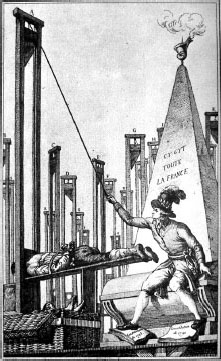
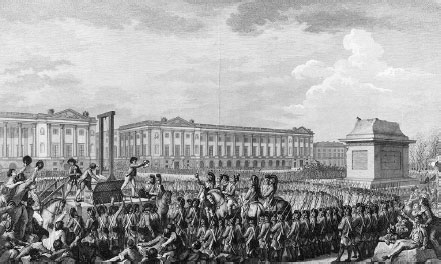
Execution of King Louis XVI on January 17, 1793.
Over 16,000 people were executed by the guillotine during the Reign of Terror in France. The Terror lasted from September,1793-July, 1794. An additional 25,000 people were killed by other means. Robespierre is shown executing the executioner in this cartoon. Robespierre, a Jacobin leader, was executed himself by the guillotine in July, 1794.196 (Wikimedia Commons)

The super frigate Constitution, “Old Ironsides,” sailed again for her 200th birthday in 1997. The ship at the Charlestown Navy Yard in Massachusetts is open to visitors year round. (Wikimedia Commons)
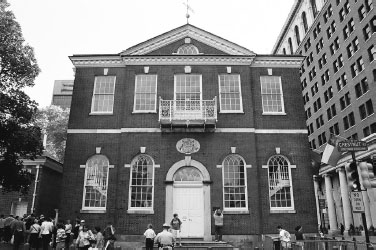
Congress met at Congress Hall from December, 1790 until May, 1800. Philadelphia was the temporary capitol of the U.S. while the new seat of federal government was being built in Washington, D. C. (Wikimedia Commons)
Despite rivalries and partisanship, both Republicans and Federalists agreed that France could not be allowed to reestablish its former empire in Louisiana. France had owned most of the continent of North America before losing it to England in the Seven Years War (1756–1763). Spain kept the land west of the Mississippi River undeveloped in order to guard its silver mines in the Sierra Madre Mountains against intrusion.
France wanted to take back Louisiana in order to grow agricultural products for Saint Domingue (Haiti), its wealthiest colony. Saint Domingue, occupying one third of the island of Hispaniola, was the world’s leading producer of sugar and coffee. Land in Saint Domingue was too precious to be used to feed its own people.
Saint Domingue underwent a slave revolution in 1791, becoming the second American colony to fight for its independence. Before the revolution, the French colony’s population was 452,000 slaves, 40,000 whites and 28,000 free blacks and mulattoes—African slaves making up nearly seven times the number of its free population. The fight for independence would take 13 years, ending with the establishment of the black republic of Haiti in 1804, the second successful colonial revolution in the Americas, and the only slave revolt to establish a new nation.
Before the revolution, some 500 U. S. ships were trading in Saint Domingue. They were supplying almost all the sugar and molasses imported into the United States. The island was the second largest market for American exports, surpassed only by Great Britain. When British troops occupied Saint Domingue in 1793, American ships brought supplies to the British occupiers. By 1797, there were over 600 American ships engaged in trade with Saint Domingue. Federalists, the party in power, favored either Britain controlling Saint Domingue or black independence. Britain lost at least 7,500 troops—or perhaps three times as many—to yellow fever while occupying Saint Domingue, before it finally retreated from the island in 1798.197
President Adams reopened trade with Saint Domingue in 1799, supplying arms and ammunitions to the black rebels. The American navy maintained a base on the island. Jefferson and the Republicans, however, were opposed to aiding the rebels, fearing the spread of slave revolts in the southern states.198
The surrender of the Spanish forts on the Mississippi and the surveying of a boundary line between Spanish and American territory was established by the Treaty of San Lorenzo (Pinckney’s Treaty) signed in 1795, which guaranteed U. S. navigation rights on the Mississippi and the free transfer of goods at New Orleans. but the actual relinquishment of Spanish forts on the Mississippi took longer than expected.

Andrew Ellicott (1754–1820) was the leading surveyor in the United States. He taught surveying methods to Meriwether Lewis before Lewis led the expedition to the Pacific Coast.
(www.explorepahistory.com)
Andrew Ellicott arrived in Natchez in February, 1797. The distinguished scientist was the U. S. Commissioner for the joint nation survey to establish the boundary line at 31 degrees north latitude between Spanish West Florida and the new Mississippi Territory. Ellicott had surveyed the western border of Pennsylvania, which established the prime meridian for Northwest Territory, and the boundary lines for the nation’s new capitol at the District of Columbia.
It was an inauspicious time for the surrender of forts—the Blount Conspiracy was still underway and the threat of British troops coming down from Canada to seize Spanish forts on the Mississippi was real. Ellicott and his party encamped on the top of a hill near the fort at Natchez and raised the flag of the United States, despite Spanish threats to cut it down. Ellicott noted in his journal that he had earlier seen a confidential letter written by Natchez Governor Gayoso in June, 1796 that said:
… the treaty was not intended to be carried into effect, and that delay on their part would reduce it to dead letter. And … that the country either was, or would be ceded to the republic of France. 199
The surrender of the Spanish forts was delayed for more than a year as Spanish officials anticipated either a British invasion or the cession of Louisiana and the Floridas to France. Things quieted down after the Blount Conspiracy was exposed, and Ellicott finally began the boundary line survey in April, 1798. Ellicott remained the senior American official in the area until General Wilkinson and Winthrop Sergeant, the first Governor of Mississippi Territory, arrived in September, 1798.
On November 14, 1798, Ellicott wrote in cipher code to Secretary of State Timothy Pickering that he had discovered General Wilkinson and several others were in the pay of Spain, and he accused them of plotting with Spanish officials—Governor Gayoso and Baron de Carondelet—to start a revolution. He reported their plan was to detach Kentucky and Tennessee, and after that, establish a new empire. Ellicott wrote:
The first object of these plotters is to detach the States of Kentucky and Tenesee from the union and place them under the protection of Spain. If that could have been effected this season the treaty would never have been carried into effect; and to ascertain the probability of such an event Mr. Power was sent in the beginning of last June into the States before mentioned.
The design of detaching the western country from the union is but a small part of the general plan which is very extensive and embraces objects of immense magnitude; nevertheless to ensure success, this point must be first carried; which being effected and by the system of promotion adopted by the court of Madrid, Govr Gayoso will be at Quito and the Baron de Carondelet at Mexico about the same time; so as soon as this arrangement takes place or sooner if the necessary officers can be corrupted a general insurrection will be attempted, and cannot fail of success if the first part succeeds. Genl Wilkinson is to proceed from Kentucky with a body of troops through the country by way of the Illinois into New Mexico which will be a central position—the route has already been explored.
Nine tenths of the officers of the Louisiana [American] regiment are at this time corrupted and the officers of the Mexican regiment which is now in this country are but little better. The apparent zeal of the Spanish officers on the Mississippi for the dignity of the Crown, is only intended to cover their designs till the great plan which is the establishment of a new empire is brought to maturity. Their principles are highly revolutionary.200
Two kinds of conspiracies—foreign and domestic—existed in the Mississippi Valley. The governments of Great Britain and France had competing plans to invade the Spanish Floridas and Louisiana and establish a new country which would include Kentucky and Tennessee. Both governments needed the support of western leaders to succeed. They each had previously owned the territory as part of their North American empires and both governments still owned islands in the Caribbean.
Spain was in a different position. It owned Louisiana and the Floridas, but its colonial officials were disloyal and plotting to establish a new empire with the assistance of Americans. Baron de Carondelet, the Governor of Louisiana and West Florida, proposed creating a Spanish province east of the Mississippi which would include Kentucky and Tennessee. This was the plan his agent Thomas Power brought to General Wilkinson in Detroit in 1797.
Ellicott said that in 1798, nine-tenths of American military personnel were ready to invade Spanish territory and that Spanish officials were supporting invasion plans. He described their principles as “highly revolutionary” and that they were making plans of “immense magnitude.” The sticking point in this conspiracy was the first condition, that the states of Kentucky and Tennessee secede from the union and become part of a Spanish province, before New Mexico would be invaded by American troops. After the invasion, citizens of New Spain would establish local governments independent of Spain; and once the conspirators were in control of the silver mines, the revolution would be exported to other countries in the Spanish colonial empire.
General Wilkinson visited Andrew Ellicott at his surveying camp for three days in October, 1798. Ellicott complained to him about his assistant surveyor, Thomas Freeman. With Wilkinson’s consent, Ellicott expelled Freeman from his surveying party, calling him “an idle, lying, troublesome, discontented, mischief-making man.” Freeman was often drunk and disobedient. He enjoyed reciting lines from Shakespeare, wielding a sword, and playing Falstaff, Shakespeare’s comedic fool.
Wilkinson and Ellicott maintained a cordial relationship as the two high ranking U. S. officials in the territory, but Ellicott naively wrote to Wilkinson on December 16th warning him that he had seen a letter written by Thomas Power—
in which your name is mentioned in a manner which astonishes me. I dare not commit any part of it to paper…. I am confident it is false.
Even though he assured the general he trusted him, Ellicott had already sent the information to Secretary of State Pickering in Washington.201
Within six months, Wikinson hired Thomas Freeman as a civilian contractor to build Fort Adams. The fort, located six miles above the 31st degree boundary line of Spanish Florida and Mississippi Territory, became the southernmost point of entry into United States territory. It was built on a 100 foot bluff overlooking the Mississippi River called Loftus Heights.202
Fort Pickering was established by the United States in 1799, 200 miles north of Fort Adams, on the site of the Spanish Fort Fernando de las Barrancas at the Chickasaw Bluffs.203 The Chickasaw Bluffs were four strategic bluffs on the east side of the Mississippi River which marked the western boundary of the Chickasaw Indian nation and had been the location of French and Spanish forts for centuries. Memphis, Tennessee would be founded here in 1819, and Meriwether Lewis would spend some of the last days of his life at Fort Pickering in September, 1809.
The two other Spanish forts acquired by the United States were Fort Natchez at Natchez, Mississippi and Fort Nogales at the mouth of the Yazoo River. Fort Nogales was renamed Fort McHenry for the Secretary of War, and Natchez became the territorial capitol of Mississippi.
William Clark had gone to the Chickasaw Bluffs in 1793 to recruit Chickasaw scouts to serve in Wayne’s army during the Ohio Valley Indian Wars. He visited it again in March, 1798, while bringing a flatboat of the Clark family’s tobacco down to New Orleans. During his travels, he sketched Fort Ferdinand and the Governor’s Spanish war vessel. Clark noted on his drawing of the boat:
The Galley that Govr Gayosoa de Lemoz stays abord of 28 men, 24 oars, one 6 pounder & 18 swivels … In 1798.
The boat appears to have been the model for the Lewis and Clark expedition boat, which is sometimes mistakenly called a keelboat, but which they called a barge.
Gayoso became the Governor General of Louisiana and West Florida in 1797, replacing the Baron de Carondelet. He granted permission for Clark to travel from New Orleans to Philadelphia by ocean ship in July, 1798. It was eight months before Clark returned to Louisville in December, 1798, having traveled 4,400 miles on his journey. 204
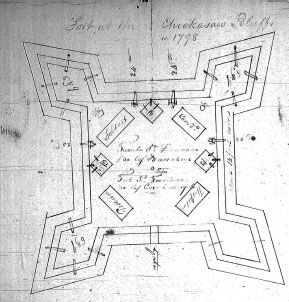
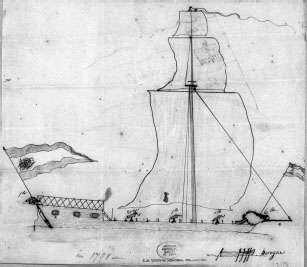
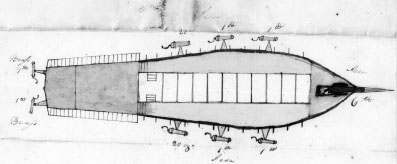
William Clark’s 1798 sketches of Fort Ferdinand and Governor Gayoso’s war vessel. (Missouri History Museum, St. Louis)205

New Spain, circa 1800